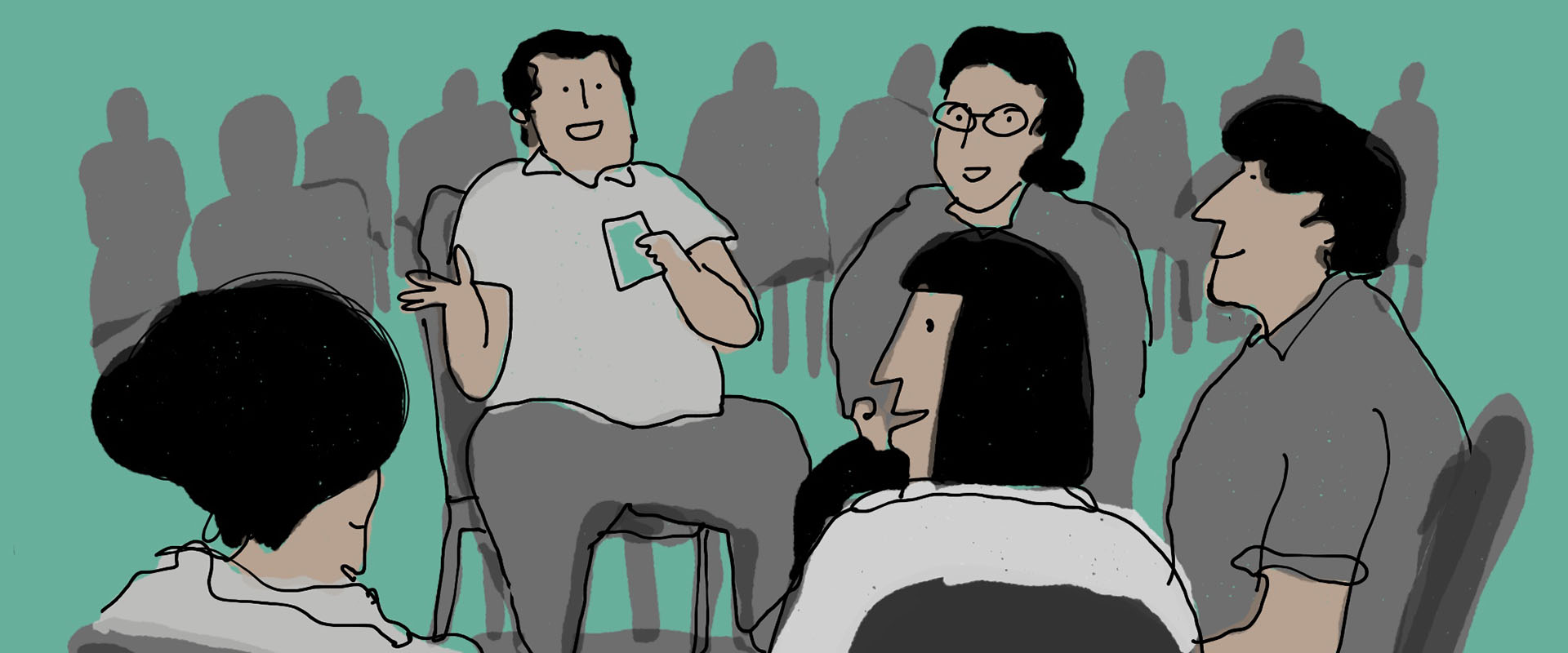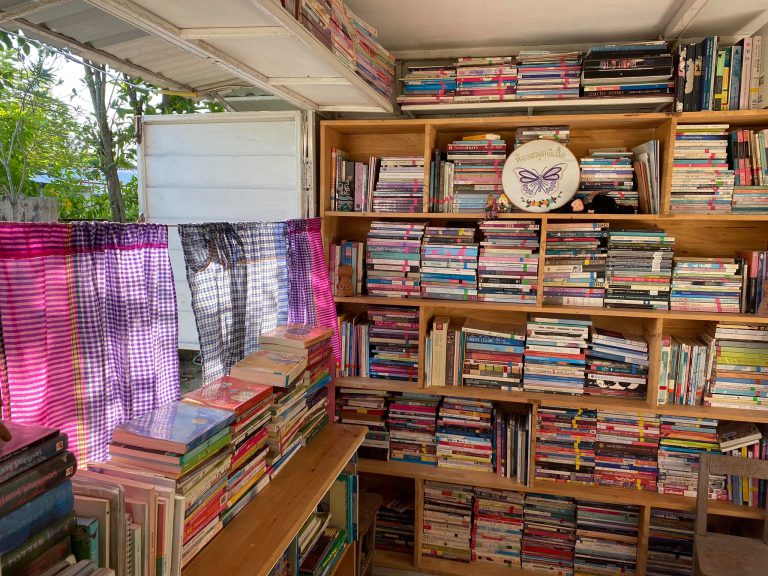Story: Patwajee Srisuwan
As a writer and columnist interested in the environment, health and self-improvement who has written multiple books on the subject of death — Mastering Funerals (ฉลาดทำศพ), Today is Gift of Life (วันนี้คือของขวัญของชีวิต), Love is all Around Us: Orathai Chafu’s Experiences in End-of-Life Care (ประสบการณ์ดูแลผู้ป่วยระยะสุดท้ายของอรทัย ชะฟู) — and worked on self-improvement projects with a focus on communication and a good death, I was invited to lead a workshop on women’s development by my hometown’s municipality. There were 40 participants, who were all involved in community public health: village health volunteers, employees of the tambon hospital, municipal staff, leaders and elders of the community.
“I began creating a fun and relaxed atmosphere of learning with icebreakers, followed by a listening exercise”.
I began creating a fun and relaxed atmosphere of learning with icebreakers, followed by a listening exercise. I divided the participants into groups of 3 and asked them to introduce themselves by responding to two prompts: they shared something that impressed them as a child or in their working life, and something at present, or in the past month, that is/was upsetting them. The participants are asked to listen attentively to each other, and not to ask questions while the speaker is still sharing. Once the speaker is finished, the listeners reiterate any significant words and reflect on the speaker’s body language.
In addition to getting to know one another better, the participants developed empathy for one another through sharing their stories. Some spoke of the physical and emotional suffering that they or their family members have experienced. Being listened to brings relief. Another product of the exercise, other than ensuring participants feel heard, was that some of the public health workers at the workshop began volunteering to visit sick community members at their homes and accompany psychiatric patients to the hospital.
However, the main objective of this workshop was to encourage the group of participants, who look after the health and well-being of the community, to reflect on and discuss life and death. With their deeper understanding, they will be able to make plans for their own life and death — as well as their loved ones and community — by asking a set of questions that can be called ‘life-changing questions’.

The Life-changing Questions
I ask my first question: “What is a good death”? Animated conversation fills the room and then fades into a long period of silence, as the participants reflect and formulate their responses.
“A good death is to die without pain or suffering, or to pass away in one’s sleep” was the answer of the majority of the room.
“Does that mean that a cancer patient in terrible pain is unable to have a peaceful death?” I responded, and brought up the example of my brother — whom most of the participants knew — who recently passed away from liver cancer.
When the doctor told my brother that his cancer had progressed to the terminal stage and could no longer be treated with chemotherapy or an operation — that all that could be done was to manage his pain — he and my family decided to treat his symptoms at home with medicine delivered from the hospital.
For approximately a month, while my brother rested and was cared for at home, relatives and friends in the community regularly came to visit. Some agreed with the decision to treat him at home, and were supportive; others tried to pressure us to admit our brother to the hospital, with some advising that “the doctor knows best”, and others commenting behind our backs that we were “leaving him to die at home”.
In the end, my brother peacefully passed away at home, cared for by his loved ones. He was given the customary deathbed rituals, according to his beliefs. The prayers he had chosen were chanted until his last breath and then a half hour after as it is believed that though the deceased has breathed their last, their spirit resides in their body for a while longer. Then, my family helped each other wipe down his body and dress him in the clothes that had been prepared.
“That was the first time I saw, with my own eyes, someone die and go as peacefully as if they were just falling asleep,” said an elderly relative who was over 80 years old. They had come to keep vigil and pray, and spoke with a tone and expression of relief, amazed at the death they had seen before them.
I consider it a good death, spiritually and socially, because both the patient and the family were able to address anything that had gone unspoken over the years, and revitalize their relationships in his last stage of life. Not only was it good for the patient, but it was also healing for the surviving relatives, who can live on without guilt.
“The person administering CPR has to use a lot of strength while the person receiving CPR is in excruciating pain”.
After the first question, the next ones flow seamlessly, accompanied by a story and personal context that “rings true” and “collectively resonates” with everyone — more so than stories about death in the media. After all, these are stories drawn from each participant’s lived experience, and some are close to the people in the stories they shared. For example, one man, who works as a village health volunteer, relates that he has been through CPR training, and so knows that the person administering CPR has to use a lot of strength, while the person receiving CPR is in excruciating pain. Another woman talks about an elderly relative with liver failure: they stopped breathing, and their family decided to allow the doctor to insert a breathing tube. The relative was in a vegetative state, completely unresponsive, for as long as 3 months before they finally passed away.

We Can Build Communities for Compassionate Death
Traditionally, societies have conventions and customs that have been passed down over many generations. The majority consider death taboo, something that shouldn’t be openly discussed. Coupled with economic and social changes, these attitudes make us see death a source of fear and scramble to distance ourselves from death at every moment.
We burden professionals such as nurses and doctors with the responsibility of affairs related to death. We have relied on these professionals for so long that we have forgotten that actually, we can care for and support family and community members through a good death, spiritually and socially, just as our grandparents peacefully and comfortably passed away at home, at the center of the “personal care” of their relatives and neighbors.
While the treatment of physical pain, so that the patient does not suffer from the symptoms of their condition, still lies within the jurisdiction of professionals, we can still organize around the spiritual and social dimensions to a good death. By familiarizing ourselves with and creating an environment that ensures individuals have a good death, we will not only be helping ourselves and our families, but also be of service to all those who choose to die at home, who are heavily reliant on the empathy and support of people in their community.
The experience of leading this workshop has shown me that talking about life and death in an open manner is akin to laying the first brick or step towards building compassionate communities that have an understanding of mortality. The key to success is in asking good questions and creating opportunities for participants to freely exchange their thoughts — particularly to learn from the personal experiences of the participants, or at times those close to them — which helps the group deepen their understanding of life and death.
Note
Readers interested in the ‘Life Unlock’ card game as a tool for initiating dialogue on life and death can reach out on Line @peacefuldeath. The game is priced at 160 baht (delivery cost not included).



